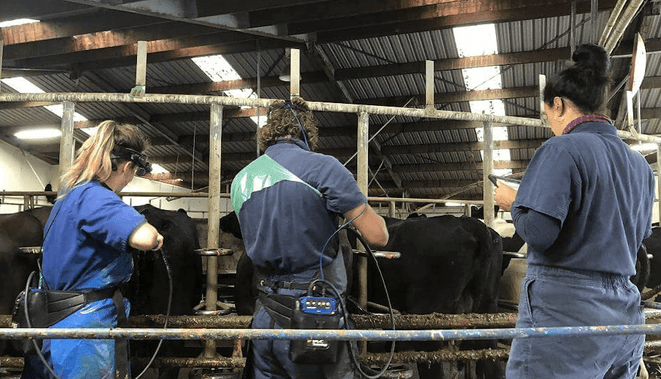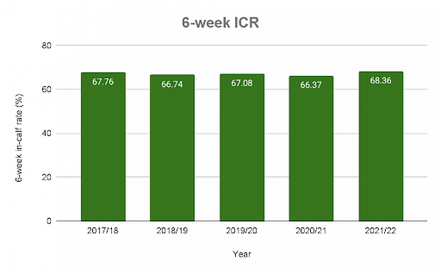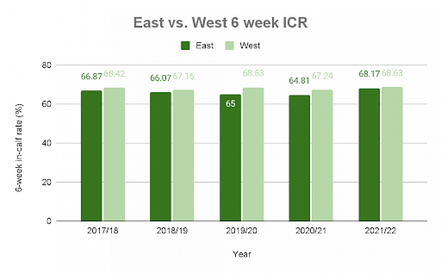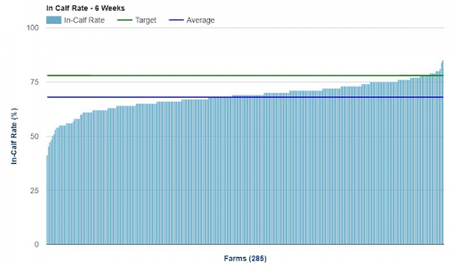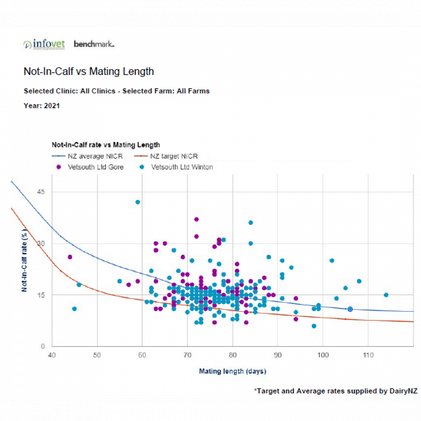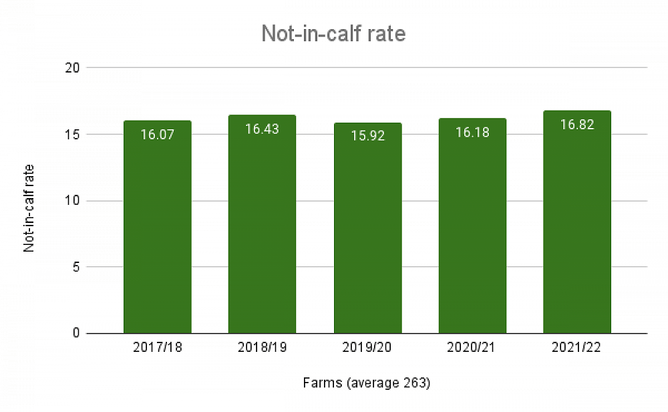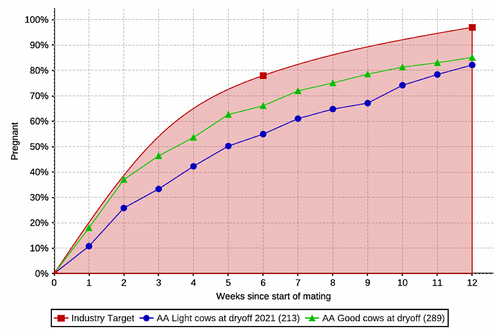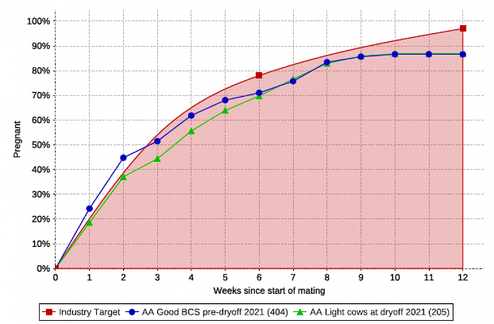Vet Bianca has dived deep into the data from across our farms and is disecting what the data means from the 6 Week In-Calf Rate (ICR).
We have collated data from the Fertility Focus Reports of our VetSouth farms to analyse regional in-calf rate trends. There have been some pleasing results this year. The average 6 week in-calf rate across VetSouth this year was 68.4%, which is an increase of 2% compared with last year. This is the biggest jump we have seen in several years and is the first time we have exceeded 68% in the 10+ years that we have been measuring.
VetSouth 6 week in-calf rate: last 5 years
A major contributor to the increase in the VetSouth average was a significant improvement in the Eastern results (Eastern Southland, West Otago & South Otago). Here we have had an average 6-week in-calf rate of around 65-66% for the last 5 years, but had an impressive 3% increase this year to over 68%. In the West, we had an average of 1% increase in 6-week in-calf rates (Central, Western and Northern Southland). Here we have traditionally had slightly higher 6-week in-calf rates, hovering around 67- 68% for the last few years.
East and West 6 week in-calf rates last 5 years
VetSouth individual farm 6 week in-calf rates 2021.22
The two main drivers of in-calf rates are submission rate and conception rate. We have seen an increase in the 3-week submission rates of both heifers and MA cows this season which has contributed to the improvement that we have seen in in-calf rates. We don’t currently have any benchmarking on conception rates, but at an individual farm level it is good to compare your herd’s conception rate on your Fertility Focus Report with targets, and with your previous years’ information to ensure that you are tracking in the right direction. We would love to help with any questions that you may have about your results.
‘Not in calf rates’ and mating length
This year our average mating length has reduced from 77 to 75 days. Mating lengths shortened significantly after inductions ended in the 2014/15 season. Back then the average mating length was 84+ days, with a ‘not in calf rate’ of around 14%. Mating lengths have remained consistent at around 77 days since then, with an average ‘not in calf rate’ of approximately 16%. This year is the first year that we have seen a significant reduction of mating length in the last 8 years. ‘Not-in-calf rates’ have had a very slight rise this year to around 16.8%, associated with the slight reduction in mating length.
VetSouth ‘Not in calf rates’ last 5 years
Set yourself up for success
Remember that setting yourself up for a good reproductive outcome requires year-round focus. Key focus areas for this stage of the season are:
- Ensuring that the herd meet dry-off BCS targets
- Ensuring winter feed will be adequate so cows can reach calving BCS targets
- Ensuring that youngstock are meeting liveweight targets.
Accurate calving date information and individual BCS results are key pieces of information for decision making at this stage of the season. Utilise BCS and calving date information for your herd to prioritise cows that may need additional help to reach dry-off and calving BCS targets. Strategic feeding, once-daily milking, early dry-off and priority feeding over winter are all tools that can be used to help ensure that you meet dry-off and calving BCS targets.
What difference does it make?
Below is an example of the impact that focussed attention on BCS in autumn and winter can have on next season’s reproductive performance. In this example, we have created a group of the cows that were BCS 4.0 or below in autumn last year, and a group of the cows that were BCS 4.5 and above in autumn. We have then compared the reproductive performance of the two groups in the following season. We have done this on two different farms and labelled them Herd A, and Herd B. Herd A was not able to ‘close the gap’ with BCS over autumn and winter. The result of this was a 10% difference in 6 week in-calf rate between the light cows in autumn vs the cows that were 4.5 and above. Herd B was able to ‘close the gap’ with targeted feeding, early dry-off for lighter cows, and preferential feeding over the winter for early calving lighter cows. The result was that the light group performed as well as the good group in the following season.
Herd A: not able to 'close the gap' in BCS between autumn and calving — Image by: Infovet
Summary
- 6-week in-calf rates improved by an average of 2% across VetSouth this season
- 3% improvement in the East
- 1% improvement in the West
- Mating length was on average 2 days shorter (77 days down to 75 days)
- A very minor increase in ‘not-in-calf-rate’ to approximately 16.8% (previously 16%)
- Our top 6-week in-calf rate this year was an impressive 85%, with a 3-week in-calf rate of 59%.
- The best ‘Not-in-calf rate’ was 7%, with three farms achieving this with a mating length of 11 weeks or less.
You can compare your own results from your Fertility Focus Report with the results above. Your Fertility Focus Report can be found on Minda (under the Reports tab), or we can generate this for you from Infovet. If you have any questions about your repro results then please contact your KeyVet for help. Now is a great time to review your reproductive performance, identify areas for improvement, and set plans in place for next season.
- Bianca McKintosh
